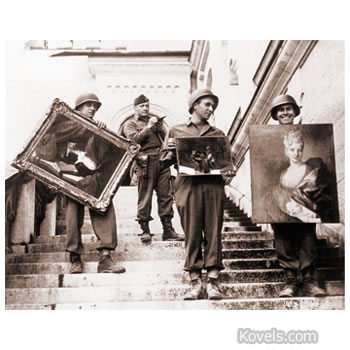Two art theft news stories met in an unexpected way this week. Twenty-two more missing artworks from the caches hidden by the Nazis at the end of World War II were located. On Nov. 9, 2013, Cornelius Gurlitt’s brother-in-law told police he was in possession of additional artworks connected to Cornelius’s trove, and police removed 22 wrapped pieces from his home. He said he wanted to be sure they were properly stored. Authorities announced a few weeks ago that more than 1,400 “lost” works of art were found in Cornelius Gurlitt’s apartment in Munich, Germany. Cornelius is the 80-year-old son of Hildebrand Gurlitt, a German art dealer who bought and sold art for the Nazis. The official story has been amended several times. The missing pictures were found in 2012, although tax collectors had been watching Cornelius since 2010. Some of the paintings were among the artworks saved by the Allies’ “Monuments Men” during and after World War II. They were a special group of soldiers selected to find and return art stolen by the Nazis to the original owners and museums. Cornelius sold one of his paintings in 2011 for $1.2 million and split the money with the auction house and the family that had originally owned the painting. Cornelius’s whereabouts are now unknown. He was never arrested, but is thought to be tax evader.
Many Germans want to know how Cornelius could sell art when it was thought to have been stolen, why the story told to the media has changed so many times, and why the Monuments Men returned some art to Hildebrand Gurlitt in 1950. (See Kovels Komments, Nov. 6, 2013; articles in the Wall Street Journal, Nov. 8 and 10; a Nov. 6 article in Financial Times; and various art publications.)
At the same time this story broke, publicity started for a new movie titled “The Monuments Men.” The movie is based on a 2009 nonfiction book with the same title. It tells the beginning of the story of how men and women sent by the Allied governments found and saved hundreds of thousands of masterpieces. The art had been hidden in salt mines and castles and protected by rubble and bomb-filled traps. We saw historic photos of the artwork, caves, and people the Monuments Men found when we attended a talk by the author of the book, Robert M. Edsel. It’s an amazing true story and current events are adding to the tale–and there’s the possibility that even more art may be found. “The Monuments Men,” which has a star-studded cast, will premiere on Feb. 7, 2014.
Photo: NYT | National Archives and Records Administration/American Jewish Historical Society/Center for Jewish History
Photo: Play4movie.com (wallpaper)





Leave a Reply
You must be logged in to post a comment.